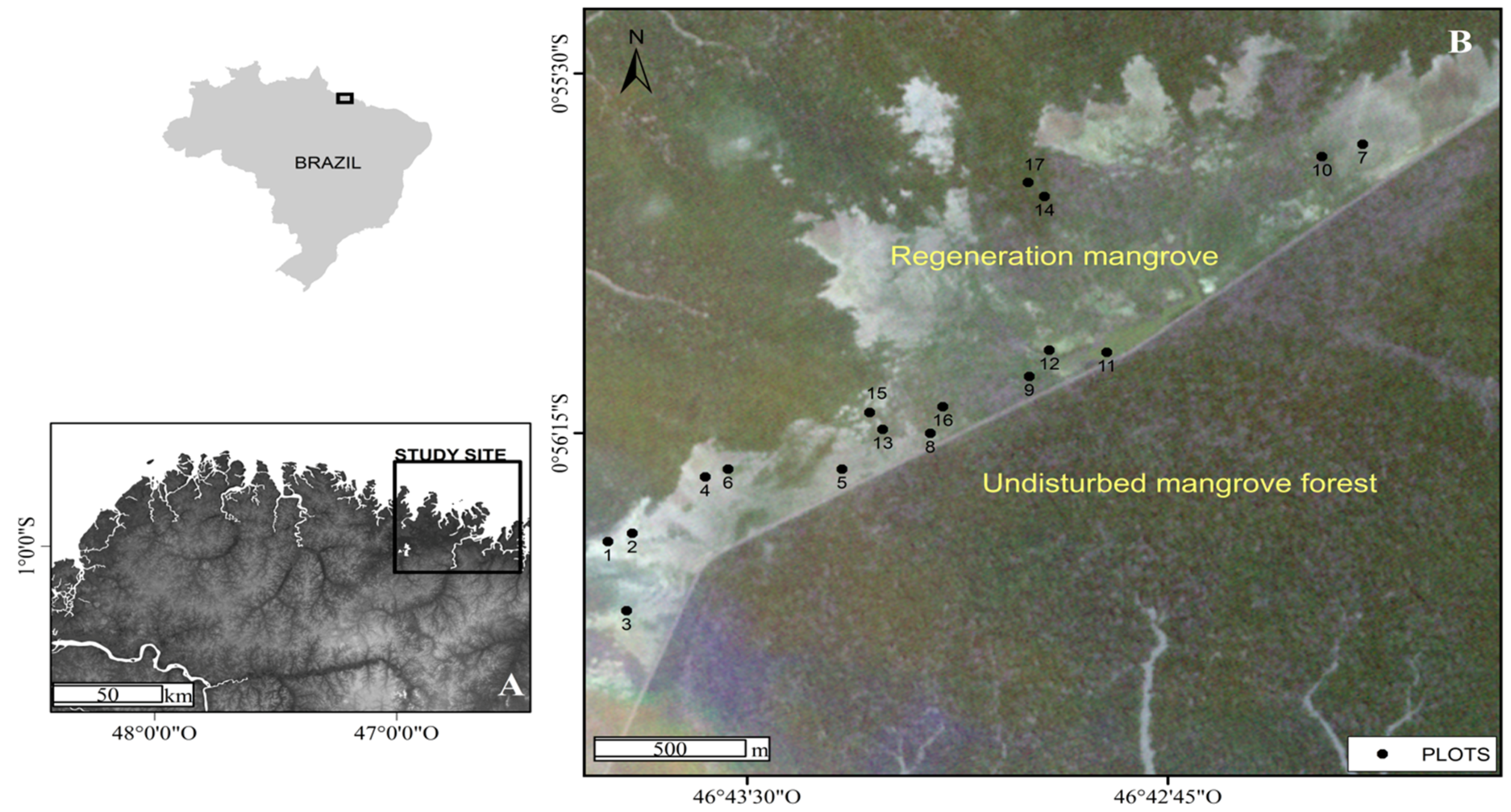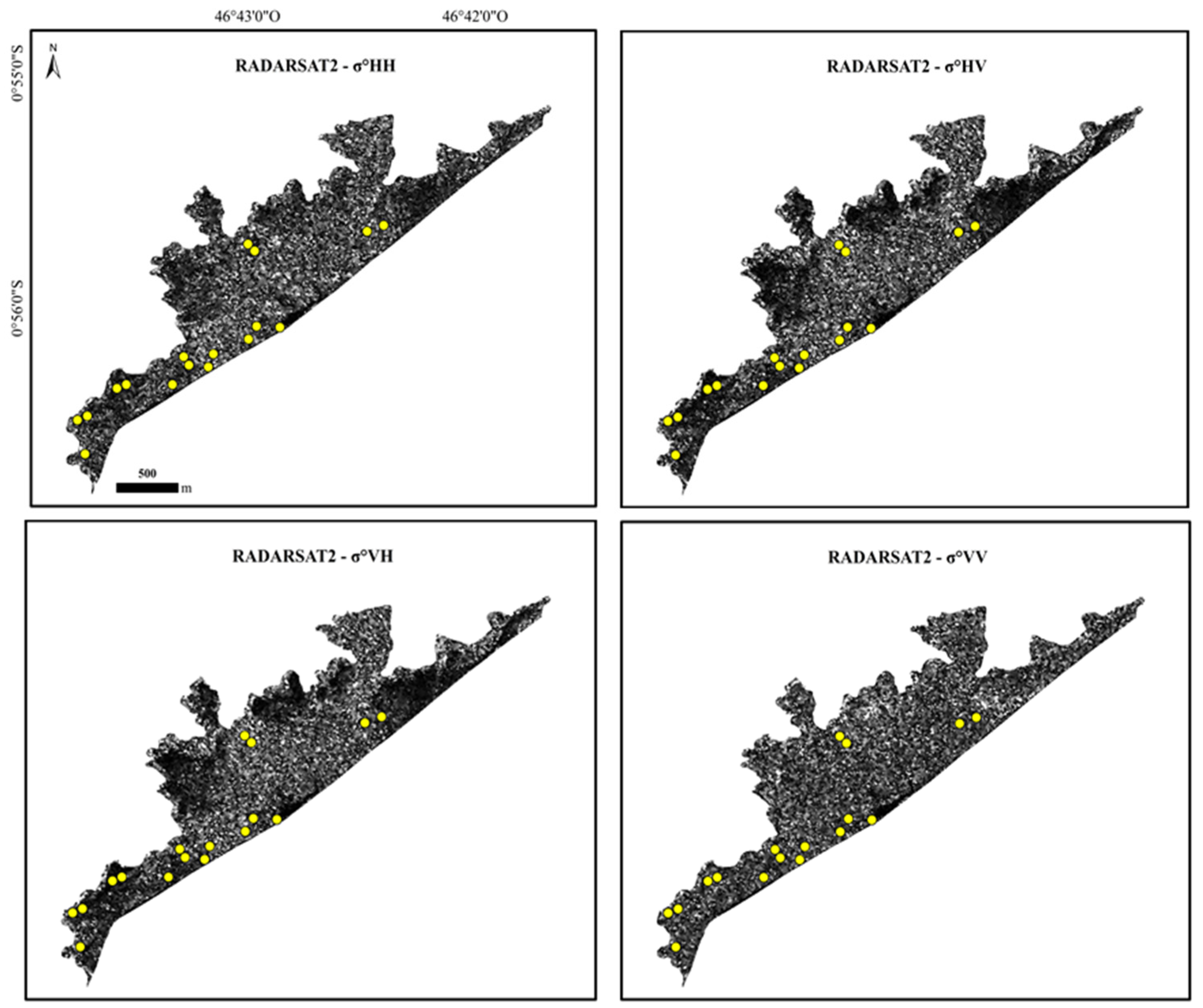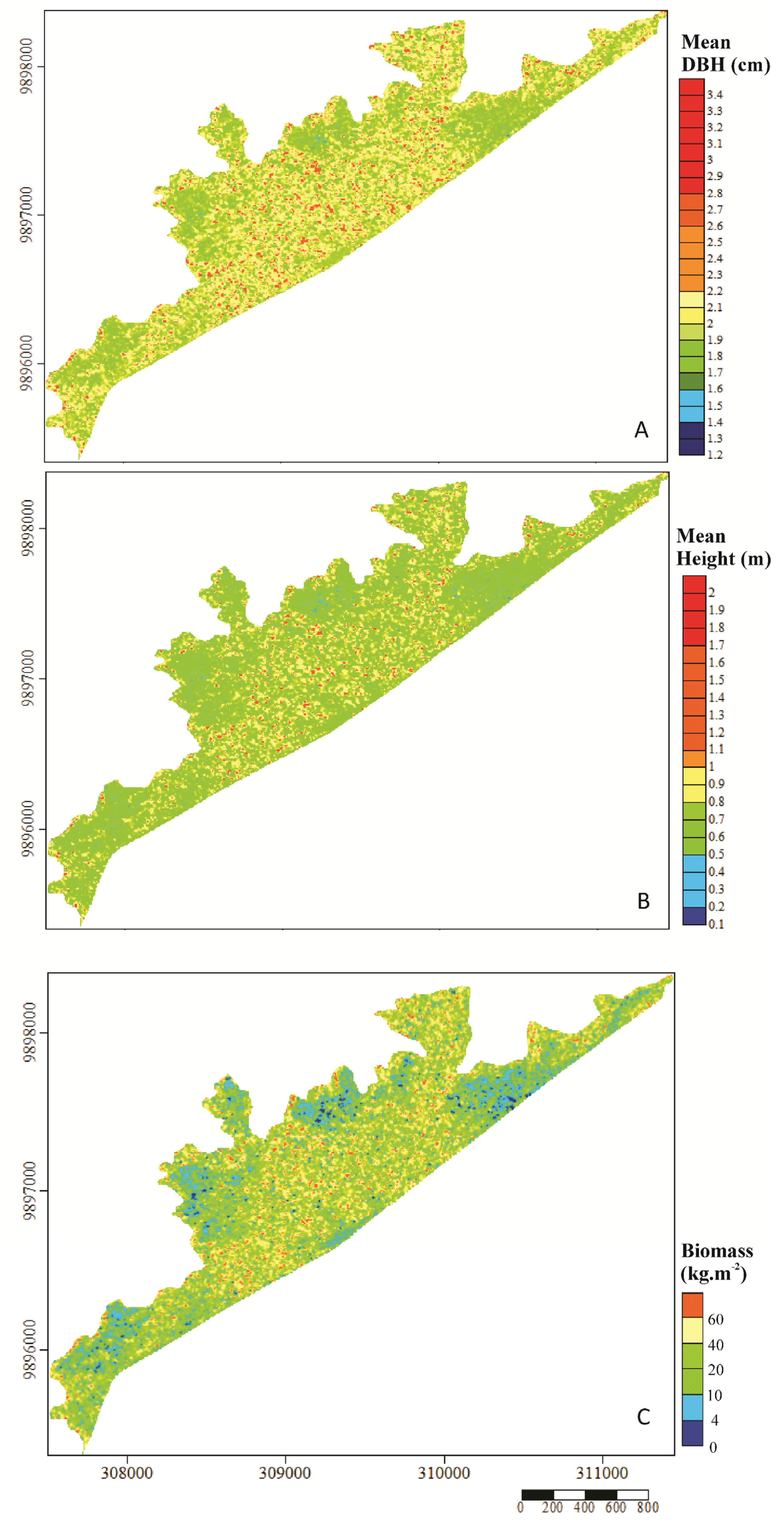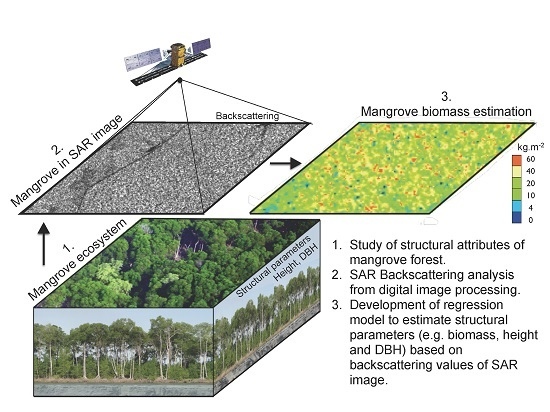3.1. SAR Attributes of the Mangrove Features
The mean backscattering values on a linear scale extracted from the Radarsat-2 image for each of the studied plots are shown in
Table 2. The cross-polarization channels showed backscattering values lower than the co-polarization channels for all reflectivity parameters. While the expected strong surface and double-bounce scattering is observed in co-polarized images, lower backscatter is observed at cross-polarizations, which results mainly from the volume scattering occurring within the mangrove canopies [
26].
Table 2.
Mean backscattering values in σ°, β° and γ extracted for each plot (P). See
Figure 3 for the location of the plots.
Table 2.
Mean backscattering values in σ°, β° and γ extracted for each plot (P). See Figure 3 for the location of the plots.
| P | σ°HH | σ°HV | σ°VH | σ°VV | β°HH | β°HV | β°VH | β°VV | γHH | γHV | γVH | γVV |
|---|
| Recent stage | 1 | 0.117 | 0.009 | 0.011 | 0.242 | 0.145 | 0.025 | 0.022 | 0.556 | 0.181 | 0.011 | 0.015 | 0.26 |
| 2 | 0.131 | 0.002 | 0.001 | 0.065 | 0.28 | 0.012 | 0.01 | 0.215 | 0.16 | 0.017 | 0.007 | 0.165 |
| 3 | 0.148 | 0.029 | 0.03 | 0.077 | 0.415 | 0.123 | 0.098 | 0.299 | 0.164 | 0.041 | 0.041 | 0.149 |
| 4 | 0.018 | 0.006 | 0.006 | 0.109 | 0.071 | 0.019 | 0.015 | 0.209 | 0.069 | 0.009 | 0.006 | 0.173 |
| 5 | 0.045 | 0.028 | 0.039 | 0.301 | 0.298 | 0.057 | 0.085 | 0.284 | 0.189 | 0.027 | 0.048 | 0.133 |
| 6 | 0.319 | 0.033 | 0.03 | 0.696 | 1.242 | 0.101 | 0.104 | 2.355 | 0.082 | 0.037 | 0.029 | 0.522 |
| Initial r. | 7 | 0.104 | 0.027 | 0.023 | 0.088 | 0.535 | 0.092 | 0.05 | 0.411 | 0.175 | 0.015 | 0.015 | 0.087 |
| 8 | 0.241 | 0.002 | 0.005 | 0.063 | 0.447 | 0.02 | 0.006 | 0.214 | 0.352 | 0.032 | 0.024 | 0.502 |
| 9 | 0.496 | 0.033 | 0.028 | 0.436 | 3.295 | 0.084 | 0.078 | 0.856 | 0.565 | 0.05 | 0.052 | 0.384 |
| 10 | 0.222 | 0.024 | 0.028 | 0.205 | 0.833 | 0.054 | 0.064 | 0.695 | 1.199 | 0.028 | 0.03 | 0.193 |
| 11 | 0.073 | 0.007 | 0.008 | 0.042 | 1.096 | 0.013 | 0.024 | 0.503 | 0.165 | 0.019 | 0.022 | 0.072 |
| Int. r. | 12 | 0.259 | 0.009 | 0.015 | 0.198 | 0.589 | 0.093 | 0.077 | 0.17 | 0.064 | 0.046 | 0.046 | 0.073 |
| 13 | 0.092 | 0.085 | 0.078 | 0.11 | 0.295 | 0.211 | 0.191 | 0.174 | 0.167 | 0.084 | 0.077 | 0.224 |
| Advanced r. | 14 | 0.145 | 0.077 | 0.073 | 0.117 | 0.104 | 0.141 | 0.14 | 0.094 | 0.198 | 0.076 | 0.077 | 0.232 |
| 15 | 0.3 | 0.029 | 0.032 | 0.126 | 0.999 | 0.069 | 0.083 | 0.256 | 0.133 | 0.056 | 0.059 | 0.306 |
| 16 | 0.346 | 0.071 | 0.049 | 0.069 | 0.935 | 0.179 | 0.098 | 0.356 | 0.345 | 0.043 | 0.033 | 0.114 |
| 17 | 0.493 | 0.039 | 0.09 | 0.276 | 1.132 | 0.164 | 0.222 | 0.645 | 0.364 | 0.028 | 0.06 | 0.274 |
The Radarsat-2 image in its different polarizations and locations of the 17 plots studied in the field is shown in
Figure 3. The observed spatial patterns in the Radarsat-2 HV image generally follow the pattern described by Souza-Filho and Paradella [
21] with strong and low backscatter in regeneration and cleared areas, respectively. The co-polarized (
i.e., HH and VV) images showed less distinction between those vegetation types. Kovacs
et al. [
17] reported that co-polarized scattering could not be used to distinguish healthy from dead mangroves. It was also observed that the high backscatter from healthy stands is related to very high crown volume scattering from the canopy (branches and leaves), while backscatter from dead and regenerating mangroves is dominated by a double-bounce scattering mechanism from standing water below the canopy acting with the trees as corner reflectors.
The predominance of higher signal returns in the central portion of all of the images (
Figure 3) suggests a greater presence of vegetation, which contributes to the occurrence of double-bounce scattering, as a result of trunk-ground interactions during high tides that reach 6 m in range. In addition, C-band images present a higher sensitivity to canopy components which substantially increases scattering at the canopy surface in addition to volume scattering.
Figure 3.
Radarsat-2 image in the four polarizations with the locations of the plots studied in the field.
Figure 3.
Radarsat-2 image in the four polarizations with the locations of the plots studied in the field.
3.2. Analysis of Canopy Structure in Regenerating Mangroves
The total area of the studied plots was 1700 m2 in which 2510 live individuals of A. germinans, 261 individuals of L. racemosa, and 30 individuals of R. mangle were measured in addition to 289 dead individuals for a total of 3090 individuals.
An ANOVA analysis was performed to evaluate the similarity between the four groups (recent stage, initial regeneration, intermediate regeneration and advanced regeneration) based on the average of the different structural attributes. Among these attributes, only density did not show significant differences (
Table 3). The
post-hoc Tukey’s test showed that BA and AGB had the most significant difference among the four groups. In
Table 4, which contains the structural attributes and respective averages separated by stage, the differences between the groups are clear, especially for the attributes BA and AGB. In relation to specific composition,
A. germinans and
L. racemosa occur in all plots; however,
A. germinans is dominant.
R. mangle occurred only in the advanced regeneration stage (Group IV).
Table 3.
Analysis of variance (ANOVA) of the structural parameters considering the groups formed in the cluster analysis of the plots (p > 0.05).
Table 3.
Analysis of variance (ANOVA) of the structural parameters considering the groups formed in the cluster analysis of the plots (p > 0.05).
| Structural Parameters | | Intercept | Group |
|---|
| Lorey’s Height | F | 43.6397 | 11.0652 |
| p-value | 0.0000 | 0.0007 |
| Mean Height | F | 57.8874 | 14.1051 |
| p-value | 0.0000 | 0.0002 |
| Max. Height | F | 58.7973 | 10.2756 |
| p-value | 0.0000 | 0.0010 |
| DBH | F | 128.5013 | 12.0889 |
| p-value | 0.0000 | 0.0005 |
| BA | F | 612.1687 | 80.2152 |
| p-value | 0.0000 | 0.0000 |
| Biomass | F | 188.3453 | 36.4730 |
| p-value | 0.0000 | 0.0000 |
| Density | F | 26.1716 | 1.0950 |
| p-value | 0.0002 | * 0.3861 |
Table 4.
Structural attributes of the plots showing the formed groups.
Table 4.
Structural attributes of the plots showing the formed groups.
| P | Group | Dominant Species | Density | Total Density | Basal Area | Mean DBH | Lorey’s | Height Mean | Max. | Total Biomass |
|---|
| (ind·ha−1) | (ind·ha−1) |
|---|
| DBH < 4 cm | DBH > 4 cm | (ind·ha−1) | (m2·ha−1) | (cm) | (m) | (m) | (m) | (kg·m−2) |
|---|
| 1 | I | Avicennia | 1600 | - | 1600 | 0.15 | 1.06 | 0.32 | 0.30 | 0.46 | 0.03 |
| 2 | | | 8100 | - | 8100 | 1.13 | 1.21 | 0.50 | 0.37 | 1.13 | 0.28 |
| 3 | | | 14,800 | - | 14,800 | 1.45 | 1.04 | 0.49 | 0.37 | 1.04 | 0.32 |
| 4 | | | 13,200 | 700 | 13,900 | 3.72 | 1.55 | 0.75 | 0.46 | 1.43 | 1.09 |
| 5 | | | 19,100 | 400 | 19,500 | 5.04 | 1.63 | 0.61 | 0.47 | 1.4 | 1.43 |
| 6 | | | 39,900 | 400 | 40,300 | 5.75 | 1.18 | 0.64 | 0.38 | 1.8 | 1.60 |
| Group average | 16,117 | 500 | 16,367 | 2.87 | 1.28 | 0.55 | 0.39 | 1.21 | 0.79 |
| 7 | II | Avicennia | 30,900 | 600 | 31,500 | 7.26 | 1.50 | 0.85 | 0.55 | 2.37 | 2.10 |
| 8 | | | 14,300 | 1500 | 15,800 | 8.31 | 2.28 | 1.39 | 0.93 | 3.1 | 2.62 |
| 9 | | | 10,100 | 1600 | 11,700 | 8.11 | 2.58 | 2.81 | 1.91 | 4.95 | 2.69 |
| 10 | | | 12,800 | 2000 | 14,800 | 10.43 | 2.62 | 2.63 | 2.03 | 4.78 | 3.36 |
| 11 | | | 7300 | 2700 | 10,000 | 10.98 | 3.20 | 2.43 | 1.57 | 4.55 | 3.82 |
| Group average | 15,080 | 1680 | 16,760 | 9.02 | 2.44 | 2.02 | 1.39 | 3.95 | 2.92 |
| 12 | III | Avicennia | 52,500 | 1200 | 53,700 | 14.56 | 1.63 | 1.95 | 1.18 | 4.13 | 4.35 |
| 13 | | | 4100 | 3100 | 7200 | 14.11 | 4.34 | 2.43 | 1.96 | 4 | 5.43 |
| Group average | 28,300 | 2150 | 30,450 | 14.34 | 2.98 | 2.19 | 1.57 | 4.07 | 4.89 |
| 14 | IV | Avicennia | 13,100 | 4700 | 17,800 | 20.42 | 3.38 | 6.95 | 5.08 | 10.85 | 6.50 |
| 15 | | | 5200 | 3800 | 9000 | 18.34 | 4.35 | 3.18 | 2.09 | 4.74 | 7.36 |
| 16 | | | 2400 | 4300 | 6700 | 20.89 | 5.63 | 4.92 | 3.88 | 7 | 9.53 |
| 17 | | | 1600 | 2100 | 3700 | 20.78 | 6.90 | 10.55 | 6.39 | 15.15 | 11.24 |
| Group average | 5575 | 3725 | 9300 | 20.11 | 5.07 | 6.40 | 4.36 | 9.44 | 8.66 |
3.3. Estimating Structural Attributes of Regenerating Mangrove Vegetation from SAR Data
The best correlation with structural attributes was found for cross-polarization backscatter (
Table 5). The VV polarization obtained low and inverse correlations, which can be related to the lower stature of the vegetation. This result may occur because we are working with a regenerating forest where horizontal scattering predominates and causes the opposite of what was described by van der Sanden [
24].
Table 5.
Correlation coefficient between structural attributes and backscattering of the Radarsat-2 image FQ5. The highest correlation coefficient values are highlighted (p < 0.05).
Table 5.
Correlation coefficient between structural attributes and backscattering of the Radarsat-2 image FQ5. The highest correlation coefficient values are highlighted (p < 0.05).
| Lorey’s Height | Mean Height | Max Height | DBH | Basal Area | Total Biomass |
|---|
| (m) | (m) | (m) | (cm) | (m2·ha−1) | (kg·ha−1) |
|---|
| β°HH | 0.20 | 0.17 | 0.22 | 0.22 | 0.15 | 0.18 |
| β°HV | 0.56 | 0.60 | 0.54 | 0.61 | 0.62 | 0.64 |
| β°VH | 0.71 | 0.70 | 0.69 | 0.67 | 0.62 | 0.68 |
| β°VV | −0.74 | −0.12 | −0.08 | −0.14 | −0.17 | −0.13 |
| σ°HH | 0.56 | 0.53 | 0.56 | 0.52 | 0.47 | 0.55 |
| σ°HV | 0.51 | 0.60 | 0.49 | 0.58 | 0.62 | 0.58 |
| σ°VH | 0.77 | 0.79 | 0.75 | 0.73 | 0.68 | 0.72 |
| σ°VV | −0.03 | −0.07 | −0.02 | −0.16 | −0.14 | −0.12 |
| γHH | 0.20 | 0.24 | 0.23 | 0.19 | 0.12 | 0.12 |
| γHV | 0.35 | 0.42 | 0.37 | 0.40 | 0.59 | 0.45 |
| γVH | 0.58 | 0.61 | 0.59 | 0.55 | 0.66 | 0.59 |
| γVV | 0.03 | 0.01 | 0.04 | 0.00 | −0.05 | −0.04 |
Different functions were fitted to the set of variables with significant correlation coefficients.
Table 6 shows that the best fit of the regression function is linear and best with the σ°
VH backscattering.
Table 6.
Models that showed higher r2 values in the three radar attributes with VH polarization as an explanatory variable (p > 0.05).
Table 6.
Models that showed higher r2 values in the three radar attributes with VH polarization as an explanatory variable (p > 0.05).
| | Lorey’s Height | | Mean Height | | Maximum Height |
| | r2 | β1 (p) | F | p | | r2 | β1 (p) | F | p | | r2 | β1 (p) | F | p |
| σ°VH | LIN | 0.59 | 0.000 | 21.909 | 0.000 | LIN | 0.63 | 0.000 | 25.237 | 0.000 | LIN | 0.57 | 0.000 | 19.587 | 0.000 |
| β°VH | LIN | 0.50 | 0.002 | 14.795 | 0.002 | LIN | 0.49 | 0.002 | 14.612 | 0.002 | LIN | 0.48 | 0.002 | 13.681 | 0.002 |
| γVH | EXP | 0.41 | 0.006 | 10.265 | 0.006 | EXP | 0.43 | 0.004 | 11.42 | 0.004 | EXP | 0.37 | 0.009 | 8.958 | 0.009 |
| | DBH | | Basal Area | | Biomass |
| | r2 | β1 (p) | F | p | | r2 | β1 (p) | F | p | | r2 | β1 (p) | F | p |
| σ°VH | LIN | 0.53 | 0.001 | 16.979 | 0.000 | LIN | 0.46 | 0.003 | 12.950 | 0.003 | LIN | 0.52 | 0.001 | 16.430 | 0.001 |
| β°VH | LIN | 0.44 | 0.003 | 11.987 | 0.000 | LIN | 0.39 | 0.008 | 9.466 | 0.008 | LIN | 0.46 | 0.003 | 12.572 | 0.003 |
| γVH | EXP | 0.35 | 0.013 | 7.944 | 0.013 | LIN | 0.44 | 0.014 | 11.671 | 0.004 | LIN | 0.35 | 0.012 | 8.073 | 0.012 |
Multiple linear regression models were subsequently fitted to potentially increase the predictive power of the regressions. The multicolinearity between the independent variables that compose these models was verified by VIF (variance inflation value), which resulted in the values of 1.41, 1.13 and 1.27 for σ°
HH, σ°
VH, and σ°
VV, respectively. These values are below the limit value of 10 indicated by Neter
et al. [
50]. The parameters of these models are provided in
Table 7.
The variable σ°
VV (β
3,
Table 7) was not statistically significant in the regression model of the attribute maximum height previously described. Therefore, it is possible that the vertical components of the vegetation are not sufficiently developed to interact with microwaves in the VV polarization.
In the residual analysis, the models met the assumptions proposed by Neter
et al. [
50]. With the PRESS values, the models produced adequate values, especially those for horizontal structures, which showed a better predictive ability in the fit regression function with an emphasis on the DBH model (
Table 8).
Although the maximum height model was simpler (
Figure 4), the average height model had a higher predictive ability based on the RMSE value. For the estimation of the horizontal structure, the model for DBH had the best predictive ability, although other models were satisfactory (
Figure 4). When comparing the verified modeling methods,
r2 values increase with the introduction of σ°
HH and σ°
VV backscattering as independent variables. The explanatory power increased between 11% and 19% for the models of height estimation and between 20% and 27% for the models of estimation of horizontal structure and AGB. The RMSE values decreased with the inclusion of these variables; the PRESS values also decreased. This indicates that these models should be chosen instead of the simple regression models [
51].
Table 7.
Parameters of the simple and multiple regression models and σ°HH, σ°VH, and σ°VV backscattering that compose the independent variables.
Table 7.
Parameters of the simple and multiple regression models and σ°HH, σ°VH, and σ°VV backscattering that compose the independent variables.
| Lorey’s Height | Mean Height | Max. Height |
| Simple | Multiple | Simple | Multiple | Simple | Multiple |
| r2 | 0.59 | 0.79 | 0.63 | 0.81 | 0.57 | 0.76 | 0.68 |
| β0 | 0.020 | −0.515 | 0.049 | −0.191 | 0.817 | 0.010 | −0.593 |
| β1 (σ°HH) | - | 0.502 | - | 0.468 | - | 0.505 | 0.636 |
| p | - | 0.006 | - | 0.007 | - | 0.008 | 0.001 |
| β2 (σ°VH) | 0.770 | 0.641 | 0.792 | 0.677 | 0.753 | 0.621 | 4.323 |
| p | 0.000 | 0.000 | 0.000 | 0.000 | 0.000 | 0.001 | 0.045 |
| β3 (σ°VV) | - | −0.329 | - | -0.356 | - | −0.318 | - |
| p | - | 0.040 | - | 0.022 | - | 0.059 | - |
| ε | 1.7894 | 1.396 | 1.1248 | 0.870 | 2.5923 | 2.082 | 2.312 |
| F | 21.909 | 15.869 | 25.237 | 18.087 | 19.587 | 13.541 | 14.743 |
| p | 0.000 | 0.000 | 0.000 | 0.000 | 0.000 | 0.000 | 0.000 |
| DBH | Total Biomass | Basal Area |
| Simple | Multiple | Simple | Multiple | * Simple | ** Simple | Multiple |
| r2 | 0.53 | 0.79 | 0.52 | 0.79 | 0.46 | 0.50 | 0.67 |
| β0 | 0.473 | 1.033 | 87.056 | 39.009 | 0.021 | 0.007 | 0.038 |
| β1 (σ°HH) | - | 0.531 | | 1278 | - | | 0.472 |
| p | - | 0.004 | | 0.003 | - | | 0.027 |
| β2 (σ°VH) | 0.729 | 0.604 | 0.723 | 7279 | 0.681 | 0.614 | 0.571 |
| p | 0.001 | 0.001 | 0.001 | 0.001 | 0.003 | 0.001 | 0.005 |
| β3 (σ°VV) | - | −0.465 | | −868 | - | | −0.422 |
| p | - | 0.007 | | 0.009 | - | | 0.035 |
| ε | 1.2193 | 0.882 | 234.83 | 168.110 | 0.0534 | 0.0514 | 0.045 |
| F | 16.979 | 16.033 | 16.430 | 16.109 | 12.950 | 15.150 | 8.788 |
| p | 0.001 | 0.000 | 0.001 | 0.000 | 0.003 | 0.001 | 0.002 |
Table 8.
PRESS values and SQR difference percentage.
Table 8.
PRESS values and SQR difference percentage.
| Multiple | Simple |
|---|
| Attribute | PRESS | SQR | % | PRESS | SQR | % |
|---|
| Lorey’s Height | 53.59 | 25.35 | 52.69 | 79.47 | 48.03 | 39.56 |
| Mean Height | 18.50 | 9.84 | 46.82 | 28.61 | 18.98 | 33.68 |
| Max. Height | 140.51 | 74.83 | 46.74 | 162.38 | 100.80 | 37.92 |
| DBH | 15.69 | 10.12 | 35.53 | 29.69 | 22.30 | 24.89 |
| Total Biomass | 639,023 | 367,408 | 42.50 | 1,072,887 | 827,197 | 22.90 |
| * Basal Area | 0.04 | 0.03 | 39.80 | 0.052 | 0.043 | 17.47 |
| ** Basal Area | - | - | - | 0.049 | 0.040 | 19.26 |
Figure 4.
Plots of the observed values against the predicted values, with respective r2 and RMSE values.
Figure 4.
Plots of the observed values against the predicted values, with respective r2 and RMSE values.
Figure 5.
Estimation map: (A) average DBH (cm) and (B) average height (m) and (C) total biomass (kg·m−2) based on the backscattering values through their multiple regression functions.
Figure 5.
Estimation map: (A) average DBH (cm) and (B) average height (m) and (C) total biomass (kg·m−2) based on the backscattering values through their multiple regression functions.
The fitted regression models were developed and validated, and then applied to the backscattering values from the Radarsat-2 FQ5 image to generate maps of DBH, average height and AGB (
Figure 5). The values shown in the average DBH map ranged between 1.2 and 3.3 cm, which is consistent with the data measured in the field, in which only four sample units had values above 3.3 cm. The map showed a few regions with DBH lower than 1.6 cm, and most of the individuals with greater DBH were in the central portion of the map and ranged from 2 to 3.3 cm. The applied parameter was the average DBH, whose model RMSE was 0.77 cm; because it is a regenerating mangrove region, the amplitude of variation of this measurement is high as a result of the structural heterogeneity. The average height ranged from 0.2 to 1.9 m and is considered consistent with the values measured in the field, especially when considering the RMSE of the model, which was 0.76 m; there were only three plots outside of this height range.
The total AGB map showed a large value variation between 0 and 60 kg·m−2. These values include all AGB measured in the field. Zero represents areas without vegetation with exposed tidal flats. The more frequent values are between 10 and 40 kg·m−2. This model seemed to overestimate AGB, which is most likely a result of double-bounce scattering.












